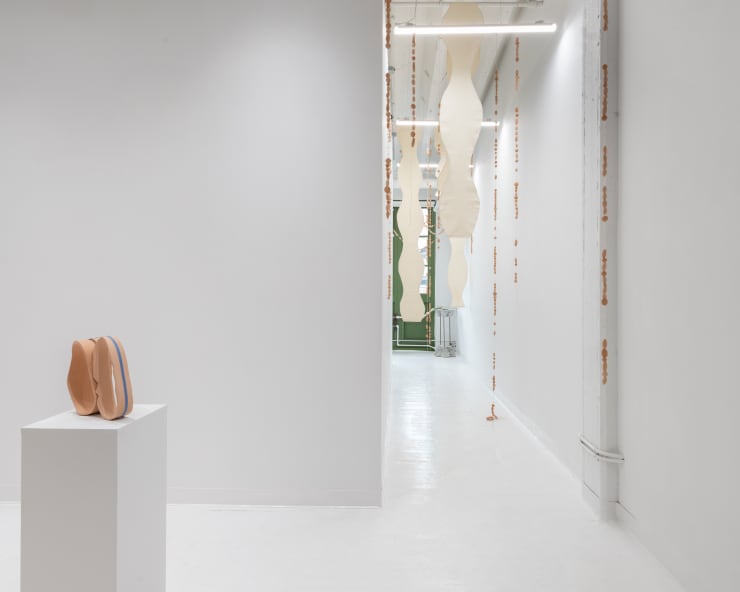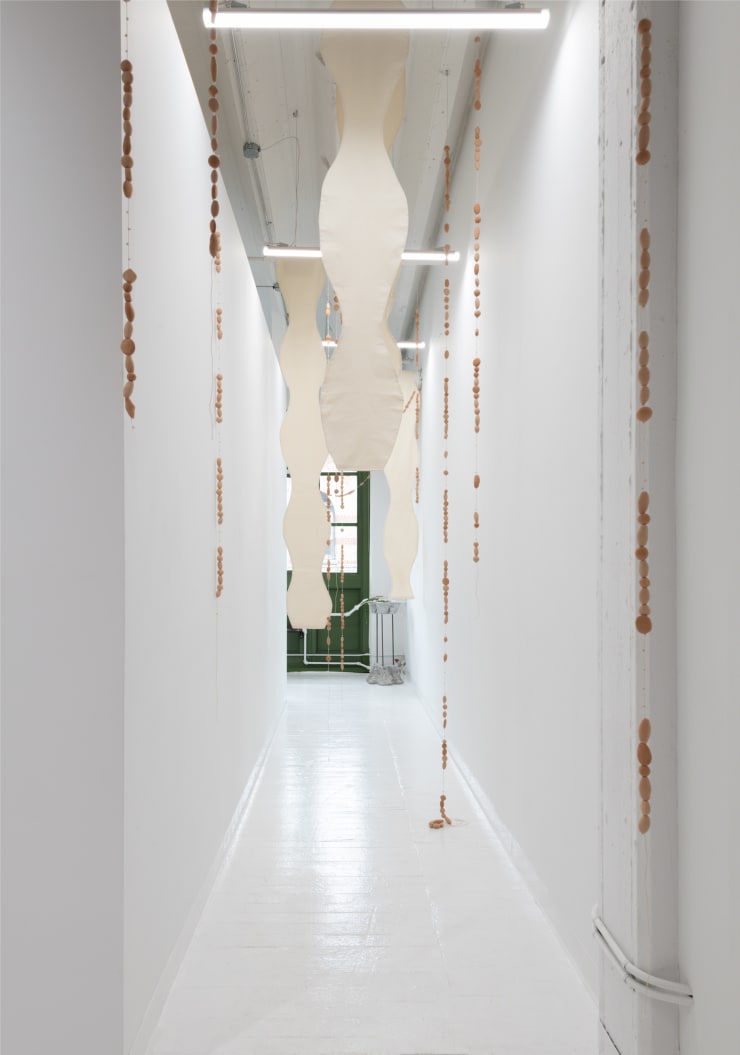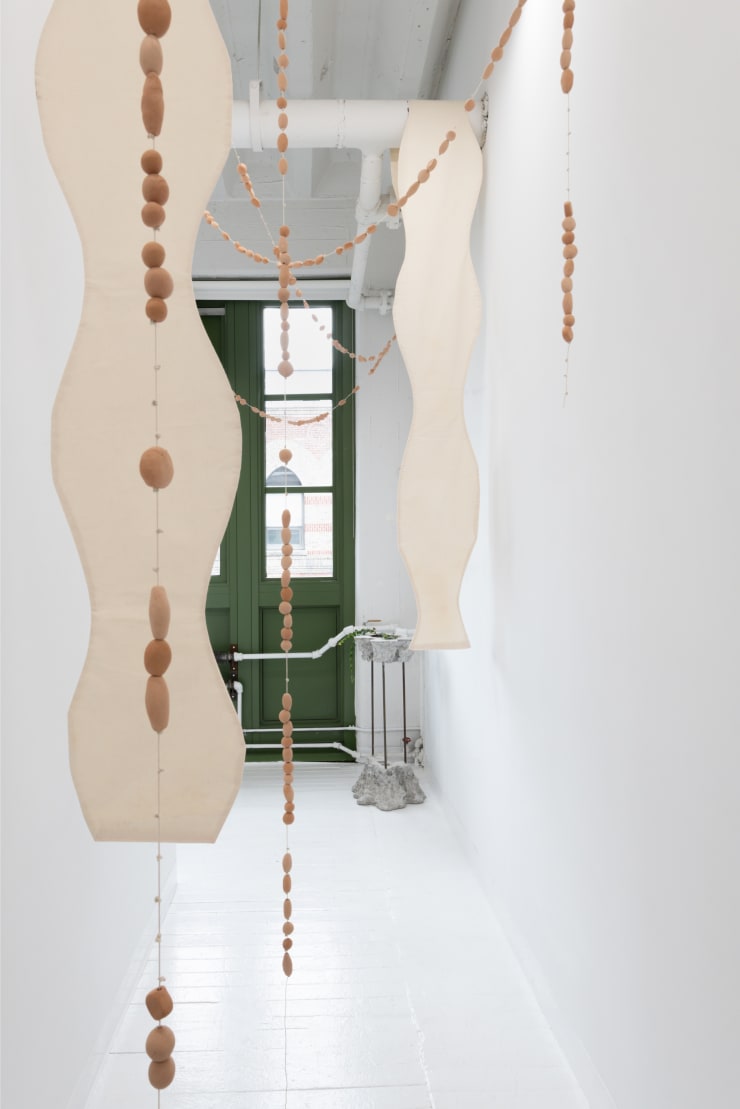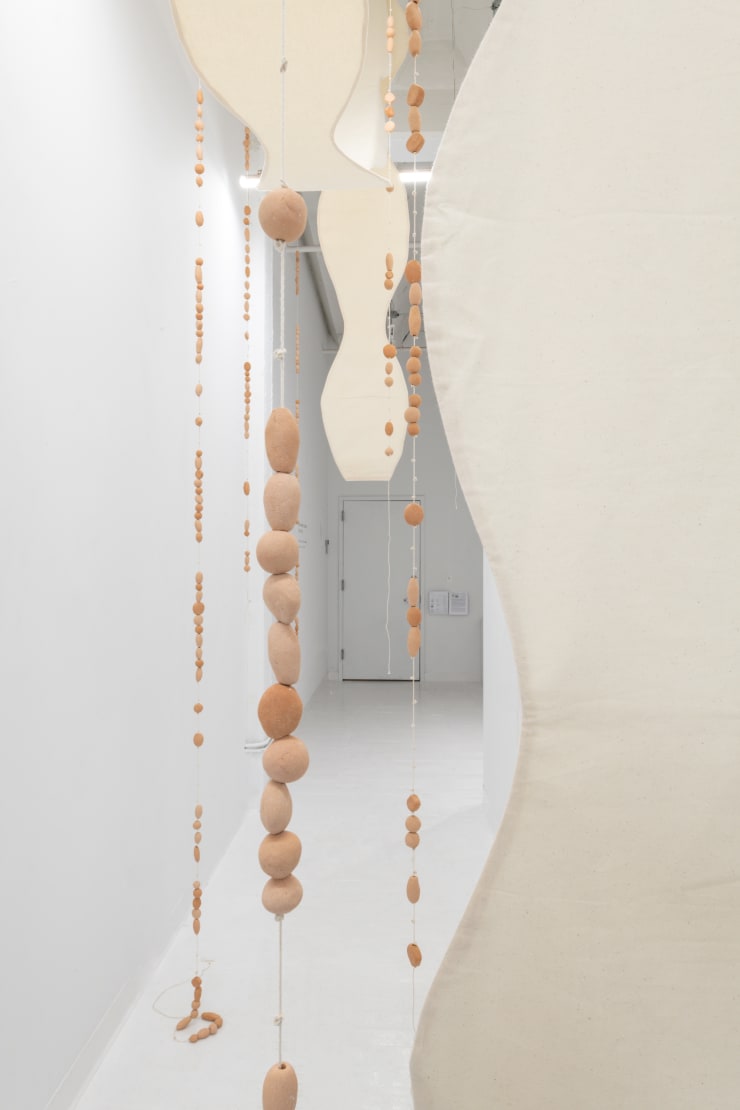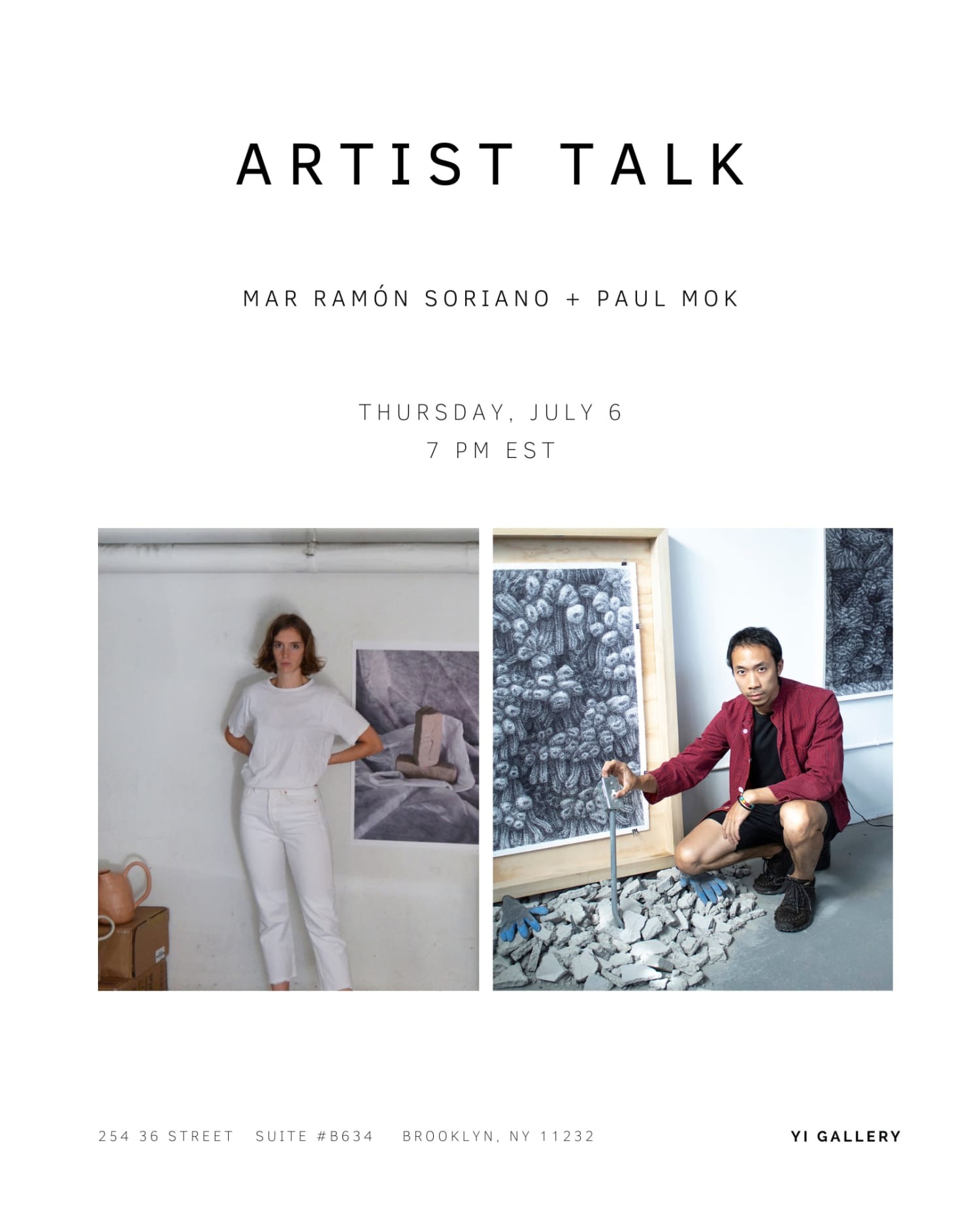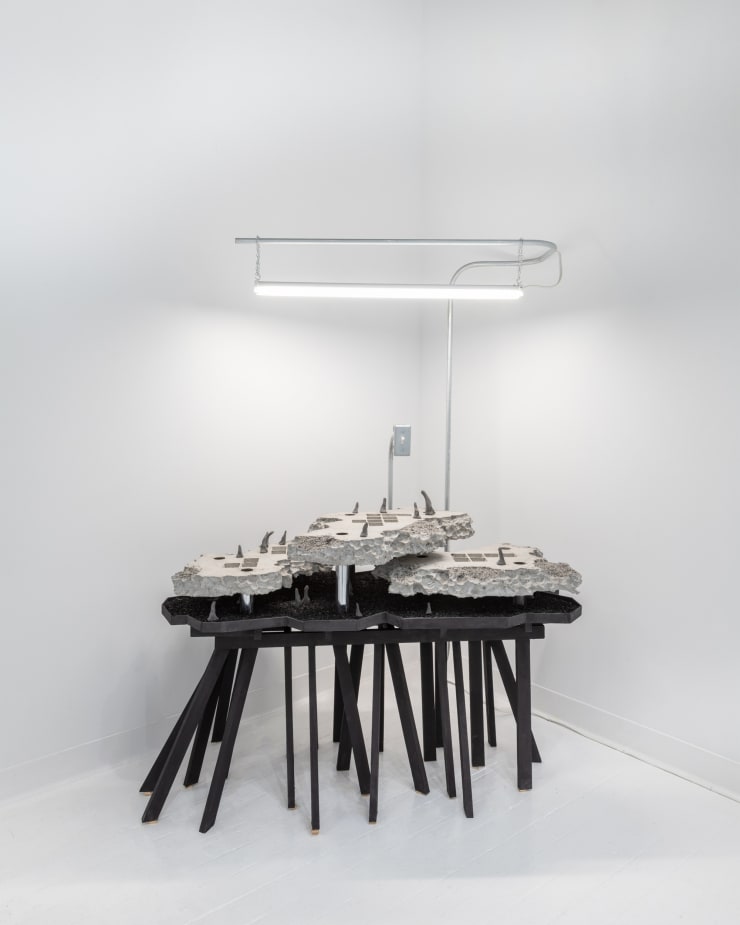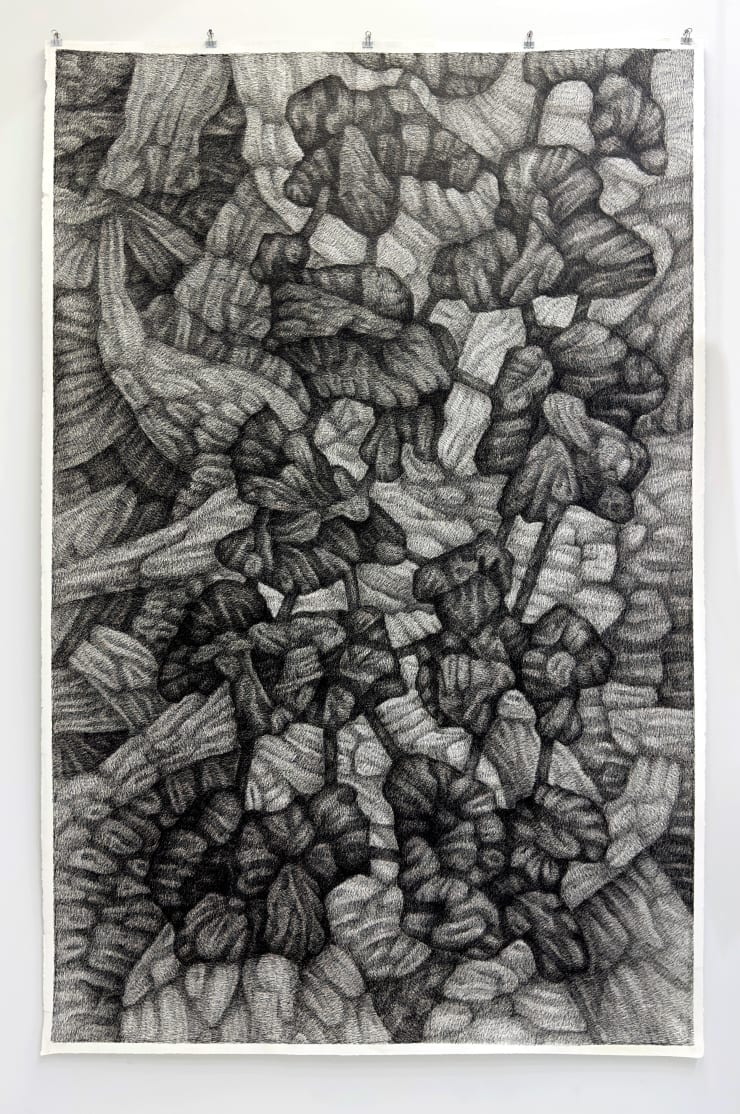An opening reception, with both artists in attendance, will take place on Saturday, June 17, from 3 to 6pm. The exhibition may be previewed by appointment from 1 to 3 pm before the public opening.
Thanks to gravity, a verticality in the body turns us into perpendicular lines to the ground. This condition is fundamental in Mar Ramón Soriano’s sculptures, influencing the placement and support of modules in space. At times, the modules are stacked as towers, exerting greater pressure on ones below. In other cases, an upper volume supports the others, generating physical tension. This tension leads her to work with specific materials, selected for their physical and poetic qualities: ropes serve the function of supporting, uniting and connecting. In her work, Mar Ramón Soriano’s ceramics symbolize the body – fragile and precariously supported. They represent emptiness, form and volume. The dialogue between soft and hard, familiar and strange, shapes a whole that seeks to make accomplices of our own bodies. “Through the dimensions of ceramics, I conquer space. I construct modules that stack on top of each other, like imposing skyscrapers or obelisks, aiming to achieve height or monumentality through the collectivization of more modest modules. These volumes enclose the seed of the body, which carries and is carried, serving as support or being supported by others.“
The installation If I collect a lot of bodies I can be as long as I want to be (2022-2023) is part of the artist’s Infinite Vase series, in which small gestures and small bodies – in repetition – conquer and define the gallery space. Canvas, pictorial material par excellence, also becomes sculpture. Between materials and bodies, there is a dialogue that can be empathetic, but can also be forced. In some cases, one body supports another, while in other instances, bodies are pressed together with elastic bands. The tension of these bands exerts enough pressure on the bodies to hold them together and constructs stable structures that can be autonomously placed on the ground. In forced meetings, pleasant meetings I (2023), a small piece of soap unfolds a narrative about body care and daily routines, while also alluding to foam, being a pre-foam themselves. Ramón is interested in the idea of foam because of the readings it offers regarding cleanliness, protection, security and fragility. Conceptually, these readings are conveyed through the writings of Peter Sloterdijk, compiled in his trilogy, Spheres. According to these texts, humans are geniuses of proximity, and foam is nothing more than a group of clustered spheres that symbolize the network of relationships established between bodies and objects. “Being-there already carries the sphere of possible neighboring” (Sloterdijk: 2004, p.16). Just as Graham Harman's object-oriented ontology theorizes the material relationships among things, Sloterdijk uses the metaphor of foam to speak about the republic of spaces. Ramón’s sculpture speaks of the individual as part of a network of connections expressed through foam, which also signifies structures or systems, including bodies, and also the spaces and objects. There is a malleable and porous entirety that relates and affects.
Drawn to common building elements, such as electrical conduits and outlets, Paul Mok composes an entire installation, Flip (2020 - 2023), surrounding a single light switch, which takes center stage. Every other element is built to support its existence: an elaborate and layered landscape made out of poured concrete and an intricate wooden base, with miniature clay figures dotted throughout the meticulously constructed scene. Front and center, in its essential mundanity and synthetic grandiosity, the switch has been transformed into something with authority. Tracing the use of concrete in his work, Mok recalls his experience in Hiroshima: “I visited the Hiroshima Peace Memorial in 2017. It was originally an industrial hall, and it was one of the very few buildings that remained standing after the bombing (because it was built out of concrete, steel and bricks, not wood). They kept it in its ruined state to memorialize the atrocities humans have committed against one another. What moved me were the plants. They were growing out of the cracks, covering the floor. They were flourishing.”
Consisting of a long “table,” roughly 2.5 by 7 ft (0.7 x 21. m), and resembling a broken piece of concrete slab from an abandoned basement, You Are Living Someone Else’s Dream (2023) was first conceived when Mok was living in a basement as a foreigner whose visa was about to expire. On the table, pieces of paper read like fortune cookie strips. But they are actually all sentences the artist wrote when he was contemplating what to put on this table in order to reveal the condition under which the artwork was conceived. It’s practically possible to put all these sentences back together to reconstruct the original writing, but the answer to “what’s on the table” will only be the artist’s original struggle in deciding what, indeed, to put on the table: “The struggle in meaning-seeking will be answered with the original struggle in meaning-making.” The artist asks, “Is it possible to fully demonstrate a first-person experience, one’s struggles and failures in making sense of one’s circumstances? Is it possible to show a sculpture as what it truly is – an unfinished attempt at meaning-making?” Mok employs a complex constellation of objects, ranging from industrial building materials and childhood photographs to handmade clay sculptures and living plants. An encyclopedic and accumulative environment, the “table” appears salvaged from a world abandoned by humans, in which plants and other creatures have begun to take over. What remains from humanity are the infrastructural ruins (the savaged concrete table) and some form of broken narrative (the cookie strips). The notion of “table,” when used as a verb; e.g., to “table” something, implies neglecting or postponing dealing with something. “I think that’s what I did to my childhood self. Over the years, I ended up suppressing, denying and despising who I was as a kid. “What's on the table” also means the things that are available for a bargain: what one is willing to trade/give up. And I think I have always traded that side of me for my career, my ambitions, etc. Yet, I think it was that “kid” who has been quietly making all these artworks in the past years. It's likely also where the anxiety captured in the fortune cookie strips stems from.”
Mar Ramón Soriano (b. 1993, Valencia, Spain) lives and works in Niñodaguia, Ourense, a small Galician town with a strong ceramic tradition. After studying fine arts at the University of Vigo, Ramón received her Ph.D. with a research in Gender as a Process in Object Art in 2022. She has participated in residencies in Spain and Portugal and is currently conducting independent research at the Observational Practice Lab / Parsons School of Design on a Fulbright scholarship. She has exhibited in CGAC (Santiago) and MARCO (Vigo) and has had solo exhibitions, including Foams, sponges (ArteSantander 2022), The infinite vase (Zona C, 2022), Empathic systems (Alterarte, 2022), A curve a wave a body (Art Mustang, 2021) and The Optimal Form/Shape (ARCO Madrid / Galería Nordés 2021).
Through a proliferation of textures and complex constellations of object, visual artist, designer and architect Paul Mok (b. 1990, Hong Kong) embeds his nuanced aesthetic language into the surfaces of industrial materials and extends into the psychological realm—dismantling material hierarchy and collapsing distinctions among categories. Mok lives and works in Brooklyn, New York. Mok graduated with a bachelor's degree in architectural studies from the University of Hong Kong and a master’s degree in architecture from the Harvard Graduate School of Design. He has exhibited at venues such as New Collectors, Art on Paper at Pier 36, Gallery GAIA and Art Mora Gallery. He has been featured in publications such as Cultured Magazine, Wallpaper, Whitehot Magazine, FAD, Art Spiel, Pattern, and Cultbyte. In 2022, Mok was named one of the Young Architects by Cultured Magazine.
* Title of the exhibition is inspired by “Every Place Is Also Another,” a
poem by Maureen N. McLane
